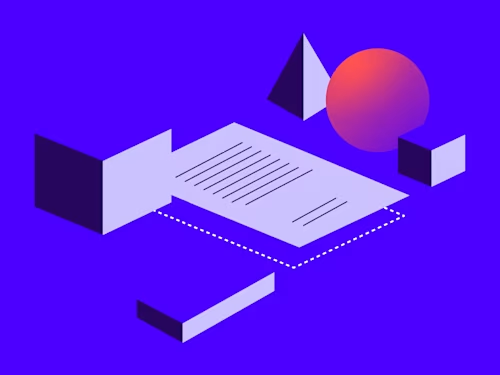
How Contract Management Technology Improves Contracting Processes and Contract Quality
Contract lifecycle management technology helps improve contract quality and processes in legal operations.
Table of contents

Like it or not, contracts are an essential part of any business. From a boilerplate NDA to a bespoke MSA, businesses must know the content of their agreements to maximize value and minimize risk. Historically, businesses relied on the ideals of “best practices” and “best guesses.” But that’s not a replacement for data-driven decision-making. We all know this to be true. How else can you account for the tremendous growth of legal operations as a pillar of well-run businesses?
According to the Corporate Legal Operations Consortium’s (“CLOC”) 2021 State of the Industry report, doing more with data is more important than ever to the function of a law department. The industry faces a widespread data hurdle, caused by the inability to access and use the critical untapped information locked in disconnected systems across siloed teams.
So, why is now the time to invest in contract lifecycle management (“CLM”) technology? Successful legal operations teams need to access and manage contract data at scale to drive value for the business. Even though basic point solutions historically claimed to do just that, only now has technology combined a centralized repository, automation and artificial intelligence (AI) into a proper contract management platform.
How CLM improves contract quality and contract processes
A data-driven approach to contract management helps organisations improve contract quality and contract processes.
But first it’s important to understand that this type of approach can only add value if the contract management platform also integrates with a business’s other systems. From CRM systems like Salesforce to HR systems like Workday, a proper contract management platform will push and pull data from these front-of-the house and back-of-the-house platforms. Further, integration with business tools like Slack and MS Word allows people to access contract tasks and information in the tools they use daily while reducing swivel chairing between systems.
Less value leakage, better contract quality
An integrated contract management platform can help you mitigate against contract value leakage and improve the quality of your agreements:
Concerned you’re failing to apply the pricing escalators you negotiated into your contracts? Link the contract data to your billing system to optimise revenue.
Concerned you aren’t taking advantage of early payment discounts or avoiding late payment fees with your vendors? Link your contract data to your ERP system to manage spend and working cost of capital.
These are just two examples of interconnected technology helping a data-driven legal operations team reduce contract value leakage.
As for contract quality, a data-driven legal operations team can drive two major processes with a proper contract management platform:
They can structure data across their legacy contracts to surface risk, manage obligations, and eliminate contract value leakage (the “look back”) and;
They can strategically incorporate the legal team’s guidance and standards in real time to keep forms current, manage a clause library, and identify risk before contracts are signed (the “look forward”).
Historically, CLMs only helped with the go-forward motions, putting processes in place to manually and incrementally add metadata with each new agreement. But AI has fundamentally changed the equation.
Looking back, AI and automation can be used to unlock essential information from your legacy agreements when they are brought into your centralised repository. Are auto-renewing contracts driving unnecessary costs? Surface those terms and end them without penalties. Concerned your older, active agreements don’t have compliant data privacy notice provisions? Leverage technology to identify the gaps, evaluate the terms, and automate the remediation process. Are global events triggering supply chain issues? The platform can find excuse of performance and related language to hold your vendors accountable for failure to meet their obligations.
Looking forward, AI and automation can be used to identify risk in your agreements before you sign them. Are your customers inserting most favoured nations pricing terms into your contracts? Find them, delete them, and leverage your automated, linked clause library to ensure your primary and fallback pricing terms are consistently applied to your sales contracts. Are your vendors attempting to eliminate their liability? Surface the clauses in their forms and make sure your preferred dollar caps are in place. Are counter-parties drafting indemnities into your agreements outside of the indemnification section? AI can find that concept (wherever it may be) so that you are not inadvertently signing up for additional liability and risk. Thanks to AI, better data leads to better agreement content and better agreement quality.
Moving to data-driven agreement processes
So, now that you have the data to stem contract value leakage and improve contract quality, how do you operationalise the information? Well, by CLOC’s own definition, you must enable legal departments to serve their clients more effectively through business and technical practices. Much of this enablement has come from transforming legal departments from their traditional business model to data-driven business units, similar to other units like sales and finance. But to become data-driven, you must also build the capabilities for legal operations to: (a) leverage that data to gain insight into risk across the business; (b) drive actionable intelligence upon which to make critical business decisions; and (c) develop predictive analytics to drive change in the organisation.
This data, in turn, fuels the ability of the legal department to eliminate costs and bottlenecks by showing quantifiable value to the organisation. Now legal departments can provide metrics and key performance indicators that drive efficiencies in the overall, cross-functional contracting process. These improved, data-driven processes lead to increased contract quality and improved coordination between the multiple lines of business involved in these transactions.
If your organisation is not already centralising, identifying and automating these challenges through a central contract management platform, it’s time. Docusign continues to invest in the technology that makes this possible every day. But more than that, we are thought leaders with deep industry, technology, implementation and value engineering teams that bring these outcomes to life every day for our customers. Put another way, it’s why Docusign is a leader in Gartner's 2021 Magic Quadrant and is also recognized as a CLM category leader by Forrester and IDCl.
Learn more about Docusign CLM.
Related posts
 Team SolutionsUpdated 11 Feb 2025
Team SolutionsUpdated 11 Feb 2025 Team SolutionsUpdated 31 Jan 2025
Team SolutionsUpdated 31 Jan 2025The customer experience disconnect: Are you missing the mark?
 Team SolutionsPublished 9 Jan 2025
Team SolutionsPublished 9 Jan 2025How We Use Docusign IAM Solutions in Legal Ops and Procurement

Drive Security, Scalability and Oversight with Docusign

The customer experience disconnect: Are you missing the mark?

How We Use Docusign IAM Solutions in Legal Ops and Procurement
Discover what's new with Docusign IAM or start with eSignature for free
